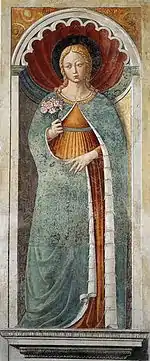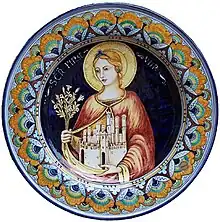Saint Fina
Fina (Serafina) (1238–1253) was an Italian Christian girl who is venerated in the Tuscan town of San Gimignano. She developed a paralytic illness and spent the rest of her life on a bed made from a wooden pallet, where Saint Gregory the Great allegedly appeared to her to predict her death. Miraculous healings were later attributed to her intercession.
Fina | |
|---|---|
 Fresco of Fina painted by Benozzo Gozzoli | |
| Virgin | |
| Born | 1238 San Gimignano, Italy |
| Died | 12 March [O.S. 5 March] 1253 San Gimignano, Italy |
| Venerated in | San Gimignano, Italy |
| Feast | March 12 and 1st Sunday of August |
| Attributes | Violets, depicted with Saint Gregory the Great, or lying on her wooden board |
| Patronage | disabled people, spinners |
Fina is celebrated in San Gimignano on both March 12, the anniversary of her death, and the first Sunday in August. Her relics are kept in a chapel in the Collegiata di San Gimignano. A hospital in San Gimignano was formerly named in her honor and several paintings of her can be found in the town.
Life

Fina dei Ciardi was born in San Gimignano in 1238. The daughter of Cambio and Imperiera Ciardi, a declined noble family, she lived in a humble house located in the historic centre of the famous “city of beautiful towers” (today the small road on which her house stands takes her name). There is little record of the first ten years of her life, and what information available comes from legends narrated after her death. Some accounts note Fina's strong devotion to the Virgin Mary, and that she went out only to hear Mass.
In 1248, Fina contracted a serious illness which progressively left her paralysed. Instead of a bed, she chose to lie on a wooden pallet. Eventually, she developed painful pressure sores. During her illness, she lost her father and later her mother died after a fall. Despite these trials she never complained, but kept a joyful countenance and gave thanks to God.[1]
Fina's immense devotion was an example to all the citizens of San Gimignano, who frequently visited her. Visitors were surprised to receive words of encouragement from a desperately ill young girl who was resigned to the will of God. Fina had a particular devotion to Saint Gregory the Great. On March 4, 1253, after five years of sickness and pain, she allegedly experienced a vision of St. Gregory, wherein he foretold her death. Fina died as predicted on March 12 at the age of 15.
Legends

Miracles attributed to Fina are mentioned in stories, paintings, poems and in notary documents. Legends say that, at the exact moment of Fina's passing away, all the bells of San Gimignano rang without anyone touching them.
When Fina's body was removed from the pallet that was her deathbed, onlookers saw white violets bloom from the wood, and smelt a fresh, floral fragrance throughout her house. Violets grow on the walls of San Gimignano. For this reason, the townspeople call them “The Saint Fina violets.”
For several days, pilgrims went to the Pieve to see Fina's remains and during that time there were reports of a number of cures. One concerned her nurse Beldia, whose hand was healed. Many sick people who visited her grave during the following years were said to have experienced cures and some of these became some of Fina's most fervent devotees.
One legend tells that during a walk with two of her friends she heard a young girl, Smeralda, crying. Smeralda had broken a pitcher that her mother had given her in order to fill with water from the public well. While she was entertained by other children, she forgot the pitcher on the ground which unfortunately rolled down and broke. Fina told her to arrange the pieces and put them under the water: the pitcher became whole and full of water.
Another anecdote about Fina's miracles is the one of the Ciardi family's neighbor. Once on the anniversary of Fina's death, when the townsfolk had declared a holiday in her honor, a neighbor, Cambio di Rustico, went to cut wood and hurt his leg. He asked Fina's pardon and was very sorry for not having respected her memorial. His cut then miraculously disappeared.
Veneration
Fina's body was brought to the Pieve Prepositura and during the transfer, the crowd proclaimed “The Saint is dead!”
Fina dei Ciardi has never been formally canonized, but her cultus is strong in her hometown of San Gimignano, where she is celebrated on two separated days. Her first feast is on March 12 – the anniversary of her death – which has been a statutory holiday in the town since 1481. The second feast on the first Sunday of August commemorates her stopping two plagues that ravaged the town in 1479 and 1631. On both days, her relics are carried in procession in order to bless the town.
The official patron saint of the town remains Saint Gimignano.
The hospital
The most important thing “produced” in the memory of Saint Fina is the “spedale” (hospital), which took her name and was built in 1255 thanks to donations given at her tomb. The hospital gave hospitality to old and poor people and pilgrims too. It became in the following century one of the best in Tuscany. The building changed its name in 1816 and remained in function until the end of the 20th century. In the hospital's chapel, the original oak wood table where Saint Fina lay down for five years is preserved.
Iconography and biographies
The most important monument dedicated to Saint Fina is her chapel in the Collegiata, designed by Giuliano da Maiano in 1468 and consecrated in 1488. Her relics are located inside the altar built by Giuliano's brother Benedetto da Maiano. On the left and right walls of the Chapel there are two frescoes painted by Domenico Ghirlandaio: one shows the vision of Saint Gregory; the other shows the funeral where the violets in blossom on the towers are represented. We also see an angel ringing the bells, Beldia's cured hand and the self-portrait of the painter and his brother-in-law Mainardi, who painted the chapel's ceiling.
Inside the Civic Museum of San Gimignano there is a wood tabernacle painted by Lorenzo di Niccolò in 1402 depicting Saint Fina holding a model of San Gimignano along with eight scenes of her life and miracles. Another image of Fina is in the nearby church of Sant'Agostino, painted by Benozzo Gozzoli. Other artists depicting the saint's life include Piero del Pollaiuolo and Pier Francesco Fiorentino.
Fra’ Giovanni del Coppo wrote the earliest hagiography of Saint Fina in the fourteenth century (“Historia vita et morte di Sancta Fina da San Gimignano”, written on 14th century and translated from Latin by Jacopo Manducci in 1575). Many others have tried to tell Saint Fina's life (Enrico Castaldi, Giovanni Bollando, Filippo Buonaccorsi, Teodoro Ferroni, Ignazio Malenotti, Luigi Pecori, Ugo Nomi Veronesi Pesciolini, and Enrico Fiumi).
The best and most updated book is “Fina dei Ciardi”, written by Profesoressa Iole Imberciadori Vichi in 1979: a deep research of all documents and biography existing in San Gimignano archives.
See also
References
- Ghezzi, Bert. Voices of the Saints Loyola Press, ISBN 9780829428063
Notes
- ^ The old Italian name was “Lo spedale”, the modern name is “L’ ospedale”.
Sources
Iole Vichi Imberciadori – Fina dei Ciardi (1979)